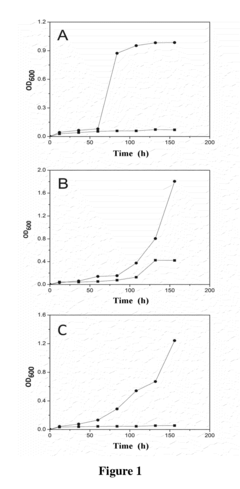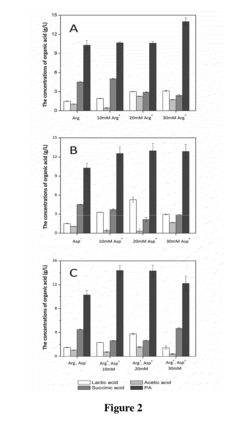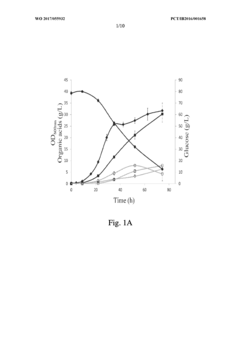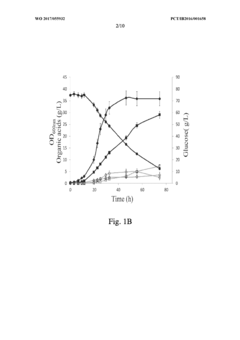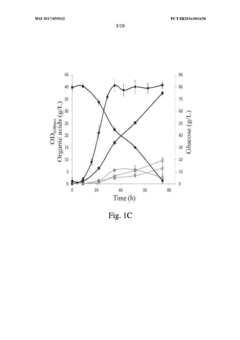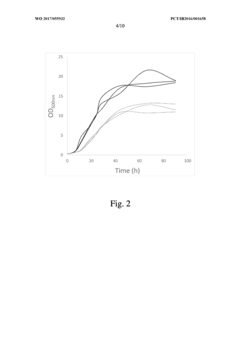Propionic Acid in Food Production: Sustainability Challenges
JUL 3, 20259 MIN READ
Generate Your Research Report Instantly with AI Agent
Patsnap Eureka helps you evaluate technical feasibility & market potential.
Propionic Acid Overview
Propionic acid is a naturally occurring carboxylic acid with the chemical formula C3H6O2. It is a colorless, oily liquid with a pungent odor, commonly found in dairy products and produced by certain bacteria in the human gut. In the food industry, propionic acid plays a crucial role as a preservative and flavor enhancer, particularly in baked goods, cheese, and other fermented products.
The compound was first discovered in 1844 by Johann Gottlieb, who isolated it from the degradation products of sugar. Its name is derived from the Greek words "protos" (first) and "pion" (fat), referring to its position as the first member of the propionic acid series. Industrially, propionic acid is primarily produced through petrochemical processes, with global production exceeding 400,000 tons annually.
In food production, propionic acid serves multiple functions. As a preservative, it inhibits the growth of mold and certain bacteria, extending the shelf life of various products. Its effectiveness is particularly notable in preventing rope spoilage in bread and other baked goods. Additionally, propionic acid contributes to the characteristic flavor profile of certain cheeses, such as Swiss cheese, where it is produced naturally during fermentation.
The compound's antimicrobial properties stem from its ability to lower the pH of food products, creating an environment inhospitable to many microorganisms. This mechanism of action allows for broad-spectrum protection against a variety of spoilage organisms, making propionic acid a versatile preservative in the food industry.
Beyond its preservative role, propionic acid finds applications in animal feed as a mold inhibitor and in the production of cellulose-based plastics, herbicides, and pharmaceuticals. Its diverse utility has led to a steady increase in demand across various sectors, with the food industry remaining a primary consumer.
However, the sustainability challenges associated with propionic acid production have become increasingly apparent. The conventional petrochemical-based manufacturing process relies heavily on non-renewable resources and generates significant environmental impacts. This has prompted research into alternative production methods, including bio-based approaches utilizing renewable feedstocks and fermentation technologies.
As the food industry continues to evolve, driven by consumer demand for cleaner labels and more sustainable practices, the role of propionic acid faces scrutiny. While its efficacy as a preservative is well-established, concerns about its synthetic origins and potential health effects have led to exploration of natural alternatives and innovative preservation techniques. This tension between functionality and sustainability underscores the complex challenges facing the use of propionic acid in modern food production.
The compound was first discovered in 1844 by Johann Gottlieb, who isolated it from the degradation products of sugar. Its name is derived from the Greek words "protos" (first) and "pion" (fat), referring to its position as the first member of the propionic acid series. Industrially, propionic acid is primarily produced through petrochemical processes, with global production exceeding 400,000 tons annually.
In food production, propionic acid serves multiple functions. As a preservative, it inhibits the growth of mold and certain bacteria, extending the shelf life of various products. Its effectiveness is particularly notable in preventing rope spoilage in bread and other baked goods. Additionally, propionic acid contributes to the characteristic flavor profile of certain cheeses, such as Swiss cheese, where it is produced naturally during fermentation.
The compound's antimicrobial properties stem from its ability to lower the pH of food products, creating an environment inhospitable to many microorganisms. This mechanism of action allows for broad-spectrum protection against a variety of spoilage organisms, making propionic acid a versatile preservative in the food industry.
Beyond its preservative role, propionic acid finds applications in animal feed as a mold inhibitor and in the production of cellulose-based plastics, herbicides, and pharmaceuticals. Its diverse utility has led to a steady increase in demand across various sectors, with the food industry remaining a primary consumer.
However, the sustainability challenges associated with propionic acid production have become increasingly apparent. The conventional petrochemical-based manufacturing process relies heavily on non-renewable resources and generates significant environmental impacts. This has prompted research into alternative production methods, including bio-based approaches utilizing renewable feedstocks and fermentation technologies.
As the food industry continues to evolve, driven by consumer demand for cleaner labels and more sustainable practices, the role of propionic acid faces scrutiny. While its efficacy as a preservative is well-established, concerns about its synthetic origins and potential health effects have led to exploration of natural alternatives and innovative preservation techniques. This tension between functionality and sustainability underscores the complex challenges facing the use of propionic acid in modern food production.
Market Demand Analysis
The market demand for propionic acid in food production has been steadily increasing due to its crucial role as a preservative and mold inhibitor. This organic compound, naturally occurring in some foods, has gained significant traction in the food industry for its ability to extend shelf life and maintain product quality.
In recent years, the global food preservatives market has experienced substantial growth, with propionic acid and its derivatives playing a pivotal role. The increasing consumer demand for convenience foods, ready-to-eat meals, and packaged bakery products has been a primary driver for this growth. As urbanization and changing lifestyles continue to shape consumer preferences, the need for effective food preservation methods has become more pronounced.
The dairy industry, in particular, has shown a strong demand for propionic acid. Its application in cheese production, where it acts as a natural preservative and contributes to flavor development, has been a significant factor in market expansion. Additionally, the bakery sector has embraced propionic acid as an essential ingredient in preventing mold growth and extending the shelf life of bread and other baked goods.
The animal feed industry has also contributed to the rising demand for propionic acid. Its use as a feed preservative and mold inhibitor in animal nutrition has gained importance, especially in regions with high humidity and challenging storage conditions. This application has opened up new market opportunities and diversified the demand landscape for propionic acid.
However, the market demand analysis also reveals emerging challenges and shifting consumer preferences that may impact future growth. There is a growing trend towards clean label products and natural preservatives, which could potentially affect the demand for synthetic propionic acid. This shift has prompted research into bio-based production methods and natural alternatives, aiming to address sustainability concerns while maintaining the efficacy of propionic acid in food preservation.
The geographical distribution of market demand shows variations, with developed regions like North America and Europe leading in consumption due to stringent food safety regulations and advanced food processing industries. Emerging economies in Asia-Pacific and Latin America are expected to drive future growth, fueled by rapid urbanization, increasing disposable incomes, and a growing processed food sector.
Despite the positive growth trajectory, the market demand for propionic acid faces challenges related to sustainability and environmental concerns. The traditional production methods, primarily based on petrochemical processes, have come under scrutiny due to their environmental impact. This has led to increased interest in developing sustainable production methods, which could reshape the market dynamics in the coming years.
In recent years, the global food preservatives market has experienced substantial growth, with propionic acid and its derivatives playing a pivotal role. The increasing consumer demand for convenience foods, ready-to-eat meals, and packaged bakery products has been a primary driver for this growth. As urbanization and changing lifestyles continue to shape consumer preferences, the need for effective food preservation methods has become more pronounced.
The dairy industry, in particular, has shown a strong demand for propionic acid. Its application in cheese production, where it acts as a natural preservative and contributes to flavor development, has been a significant factor in market expansion. Additionally, the bakery sector has embraced propionic acid as an essential ingredient in preventing mold growth and extending the shelf life of bread and other baked goods.
The animal feed industry has also contributed to the rising demand for propionic acid. Its use as a feed preservative and mold inhibitor in animal nutrition has gained importance, especially in regions with high humidity and challenging storage conditions. This application has opened up new market opportunities and diversified the demand landscape for propionic acid.
However, the market demand analysis also reveals emerging challenges and shifting consumer preferences that may impact future growth. There is a growing trend towards clean label products and natural preservatives, which could potentially affect the demand for synthetic propionic acid. This shift has prompted research into bio-based production methods and natural alternatives, aiming to address sustainability concerns while maintaining the efficacy of propionic acid in food preservation.
The geographical distribution of market demand shows variations, with developed regions like North America and Europe leading in consumption due to stringent food safety regulations and advanced food processing industries. Emerging economies in Asia-Pacific and Latin America are expected to drive future growth, fueled by rapid urbanization, increasing disposable incomes, and a growing processed food sector.
Despite the positive growth trajectory, the market demand for propionic acid faces challenges related to sustainability and environmental concerns. The traditional production methods, primarily based on petrochemical processes, have come under scrutiny due to their environmental impact. This has led to increased interest in developing sustainable production methods, which could reshape the market dynamics in the coming years.
Sustainability Challenges
The use of propionic acid in food production faces several sustainability challenges that need to be addressed for long-term viability. One of the primary concerns is the environmental impact of its production process. Traditional methods of synthesizing propionic acid often rely on petrochemical feedstocks, which are non-renewable resources and contribute to greenhouse gas emissions. The energy-intensive nature of these processes further exacerbates their carbon footprint, raising questions about the overall sustainability of propionic acid production.
Another significant challenge lies in the disposal and potential environmental accumulation of propionic acid and its derivatives. While the compound is biodegradable, improper handling or excessive use in food production can lead to its release into ecosystems, potentially affecting aquatic life and soil microorganisms. This necessitates the development of more efficient application methods and improved waste management strategies to minimize environmental impact.
The increasing demand for propionic acid in the food industry also puts pressure on production capacity, potentially leading to resource depletion and price volatility. This situation calls for the exploration of alternative, more sustainable sources and production methods. Biotechnological approaches, such as microbial fermentation using renewable feedstocks, show promise but face challenges in scaling up to meet industrial demands while maintaining economic viability.
Food safety and regulatory compliance present additional sustainability challenges. As consumers become more health-conscious and regulations tighten, there is a growing need for natural and clean-label preservatives. This trend puts pressure on the industry to develop more sustainable and consumer-friendly alternatives to synthetic propionic acid, or to improve the perception and acceptance of current propionic acid products.
The global nature of the food supply chain introduces complexities in ensuring sustainable practices across different regions. Variations in environmental regulations, production standards, and consumer preferences worldwide make it challenging to implement uniform sustainability measures for propionic acid use. This necessitates a coordinated international approach to address sustainability issues and promote best practices in its production and application.
Lastly, the economic sustainability of propionic acid in food production is closely tied to fluctuations in raw material costs and energy prices. Developing more cost-effective and energy-efficient production methods is crucial for maintaining the economic viability of propionic acid use in the food industry while meeting sustainability goals. This challenge requires ongoing research and innovation to optimize production processes and explore alternative feedstocks that can provide both economic and environmental benefits.
Another significant challenge lies in the disposal and potential environmental accumulation of propionic acid and its derivatives. While the compound is biodegradable, improper handling or excessive use in food production can lead to its release into ecosystems, potentially affecting aquatic life and soil microorganisms. This necessitates the development of more efficient application methods and improved waste management strategies to minimize environmental impact.
The increasing demand for propionic acid in the food industry also puts pressure on production capacity, potentially leading to resource depletion and price volatility. This situation calls for the exploration of alternative, more sustainable sources and production methods. Biotechnological approaches, such as microbial fermentation using renewable feedstocks, show promise but face challenges in scaling up to meet industrial demands while maintaining economic viability.
Food safety and regulatory compliance present additional sustainability challenges. As consumers become more health-conscious and regulations tighten, there is a growing need for natural and clean-label preservatives. This trend puts pressure on the industry to develop more sustainable and consumer-friendly alternatives to synthetic propionic acid, or to improve the perception and acceptance of current propionic acid products.
The global nature of the food supply chain introduces complexities in ensuring sustainable practices across different regions. Variations in environmental regulations, production standards, and consumer preferences worldwide make it challenging to implement uniform sustainability measures for propionic acid use. This necessitates a coordinated international approach to address sustainability issues and promote best practices in its production and application.
Lastly, the economic sustainability of propionic acid in food production is closely tied to fluctuations in raw material costs and energy prices. Developing more cost-effective and energy-efficient production methods is crucial for maintaining the economic viability of propionic acid use in the food industry while meeting sustainability goals. This challenge requires ongoing research and innovation to optimize production processes and explore alternative feedstocks that can provide both economic and environmental benefits.
Current Production Methods
01 Sustainable production methods
Various sustainable methods for producing propionic acid have been developed, including fermentation processes using renewable resources and bio-based feedstocks. These methods aim to reduce environmental impact and improve overall sustainability of propionic acid production.- Sustainable production methods: Developing sustainable production methods for propionic acid is a key focus. This includes using renewable feedstocks, implementing green chemistry principles, and optimizing fermentation processes to reduce environmental impact and improve efficiency.
- Biosynthesis and fermentation: Utilizing biosynthesis and fermentation techniques to produce propionic acid from renewable resources. This approach involves using microorganisms to convert biomass or other sustainable feedstocks into propionic acid, reducing reliance on petrochemical-based production methods.
- Recycling and waste reduction: Implementing recycling processes and waste reduction strategies in propionic acid production. This includes developing closed-loop systems, recovering and reusing byproducts, and minimizing waste generation to enhance the overall sustainability of the production process.
- Energy-efficient processes: Designing and implementing energy-efficient processes for propionic acid production. This involves optimizing reaction conditions, improving heat recovery systems, and utilizing renewable energy sources to reduce the carbon footprint of production facilities.
- Alternative feedstocks: Exploring and utilizing alternative feedstocks for propionic acid production. This includes investigating the use of agricultural waste, industrial byproducts, and other sustainable raw materials to replace traditional petrochemical-based feedstocks and improve the overall sustainability of the production process.
02 Recycling and waste reduction
Techniques for recycling propionic acid and reducing waste in its production and use have been implemented. These include recovery processes, closed-loop systems, and methods to minimize byproducts, contributing to improved sustainability in the propionic acid industry.Expand Specific Solutions03 Green chemistry applications
Propionic acid is being utilized in various green chemistry applications, such as bio-based polymers, environmentally friendly solvents, and sustainable preservatives. These applications contribute to reducing the environmental footprint of industries using propionic acid.Expand Specific Solutions04 Energy-efficient processes
Innovations in energy-efficient processes for propionic acid production and purification have been developed. These include optimized reaction conditions, improved catalysts, and advanced separation techniques that reduce energy consumption and enhance sustainability.Expand Specific Solutions05 Life cycle assessment and optimization
Comprehensive life cycle assessments of propionic acid production and use have been conducted to identify areas for sustainability improvement. This has led to optimizations in raw material sourcing, manufacturing processes, and end-of-life management to enhance the overall environmental performance of propionic acid.Expand Specific Solutions
Key Industry Players
The propionic acid market in food production is in a growth phase, driven by increasing demand for natural preservatives and sustainable solutions. The global market size is expanding, with projections indicating continued growth due to rising food safety concerns and clean label trends. Technologically, the field is advancing, with companies like BASF, Dow Chemical, and Eastman Chemical leading in traditional production methods. However, emerging players such as BioVeritas and Kemin Industries are exploring innovative bio-based production techniques, signaling a shift towards more sustainable practices. This competitive landscape reflects a balance between established chemical giants and newer biotechnology-focused entrants, all striving to address the sustainability challenges in propionic acid production for the food industry.
BASF Corp.
Technical Solution: BASF has developed a sustainable production method for propionic acid using renewable resources. Their approach involves fermenting sugar-based feedstocks with proprietary microorganisms to produce propionic acid. This bio-based process significantly reduces greenhouse gas emissions compared to traditional petrochemical routes [1]. BASF has also implemented advanced purification techniques to ensure high product quality. The company is exploring the use of agricultural waste and other sustainable carbon sources to further improve the environmental profile of their propionic acid production [2].
Strengths: Renewable feedstock, reduced carbon footprint, scalable production. Weaknesses: Potentially higher production costs, dependence on agricultural inputs.
Kemin Industries, Inc.
Technical Solution: Kemin Industries has developed a novel approach to propionic acid production focusing on sustainability and efficiency. Their method utilizes a proprietary fermentation process with specially selected microorganisms capable of converting various organic waste streams into propionic acid. This process not only addresses waste management issues but also reduces the reliance on fossil fuel-based raw materials [3]. Kemin has also implemented advanced process control systems to optimize yield and minimize energy consumption. Additionally, they are investigating the integration of renewable energy sources in their production facilities to further reduce the environmental impact [4].
Strengths: Waste valorization, reduced dependence on fossil fuels, potential for circular economy integration. Weaknesses: Possible variability in feedstock quality, need for specialized equipment.
Innovative Technologies
Method for Improving Acid tolerance of Propionibacterium acdipropionici
PatentInactiveUS20140178952A1
Innovation
- Adding arginine and/or aspartic acid to the culture medium during the cultivation of Propionibacterium acdipropionici to enhance acid tolerance and propionic acid productivity.
Improved propionibacterium strains for the production of propionic acid
PatentWO2017055932A2
Innovation
- Genome shuffling between selected Propionibacterium strains, such as P. acidipropionici ATCC 4875 and P. acidipropionici ATCC 55737, to generate novel strains with enhanced growth rates and propionic acid production, utilizing genetic material exchange to create strains with improved metabolic pathways and regulatory mechanisms.
Environmental Regulations
Environmental regulations play a crucial role in shaping the sustainability landscape for propionic acid production in the food industry. These regulations are designed to mitigate the environmental impact of industrial processes and promote sustainable practices throughout the supply chain.
In recent years, regulatory bodies worldwide have implemented stricter guidelines for chemical production, including propionic acid. These regulations focus on reducing greenhouse gas emissions, minimizing water pollution, and ensuring proper waste management. For instance, the European Union's Industrial Emissions Directive (IED) sets stringent limits on emissions from large industrial facilities, including those producing propionic acid.
The United States Environmental Protection Agency (EPA) has also established regulations under the Clean Air Act and Clean Water Act that directly impact propionic acid production. These regulations mandate the use of best available control technologies (BACT) to reduce air pollutants and require facilities to obtain permits for wastewater discharge.
Furthermore, many countries have introduced carbon pricing mechanisms, such as cap-and-trade systems or carbon taxes, which incentivize companies to reduce their carbon footprint. This has led to increased pressure on propionic acid producers to adopt more energy-efficient processes and explore renewable feedstocks.
Waste management regulations have also become more stringent, requiring producers to implement proper disposal methods for by-products and waste materials generated during propionic acid production. This includes regulations on hazardous waste handling, storage, and transportation.
In response to these regulatory pressures, the propionic acid industry has been investing in cleaner production technologies and exploring alternative production methods. For example, some companies are investigating bio-based production routes using renewable feedstocks, which can potentially reduce environmental impact and comply with stricter regulations.
The regulatory landscape is continuously evolving, with a trend towards more comprehensive and stringent environmental standards. This presents both challenges and opportunities for propionic acid producers in the food industry. While compliance with these regulations may require significant investments in technology and process improvements, it also drives innovation and can lead to more sustainable and efficient production methods in the long term.
In recent years, regulatory bodies worldwide have implemented stricter guidelines for chemical production, including propionic acid. These regulations focus on reducing greenhouse gas emissions, minimizing water pollution, and ensuring proper waste management. For instance, the European Union's Industrial Emissions Directive (IED) sets stringent limits on emissions from large industrial facilities, including those producing propionic acid.
The United States Environmental Protection Agency (EPA) has also established regulations under the Clean Air Act and Clean Water Act that directly impact propionic acid production. These regulations mandate the use of best available control technologies (BACT) to reduce air pollutants and require facilities to obtain permits for wastewater discharge.
Furthermore, many countries have introduced carbon pricing mechanisms, such as cap-and-trade systems or carbon taxes, which incentivize companies to reduce their carbon footprint. This has led to increased pressure on propionic acid producers to adopt more energy-efficient processes and explore renewable feedstocks.
Waste management regulations have also become more stringent, requiring producers to implement proper disposal methods for by-products and waste materials generated during propionic acid production. This includes regulations on hazardous waste handling, storage, and transportation.
In response to these regulatory pressures, the propionic acid industry has been investing in cleaner production technologies and exploring alternative production methods. For example, some companies are investigating bio-based production routes using renewable feedstocks, which can potentially reduce environmental impact and comply with stricter regulations.
The regulatory landscape is continuously evolving, with a trend towards more comprehensive and stringent environmental standards. This presents both challenges and opportunities for propionic acid producers in the food industry. While compliance with these regulations may require significant investments in technology and process improvements, it also drives innovation and can lead to more sustainable and efficient production methods in the long term.
Life Cycle Assessment
Life Cycle Assessment (LCA) is a crucial tool for evaluating the environmental impacts of propionic acid production in the food industry. This comprehensive approach considers the entire lifecycle of propionic acid, from raw material extraction to disposal, providing valuable insights into its sustainability challenges.
The production of propionic acid typically begins with the petrochemical route, using propanol or propionaldehyde as feedstock. This process involves several energy-intensive steps, including oxidation and purification. The LCA reveals significant environmental burdens associated with fossil fuel consumption and greenhouse gas emissions during these stages.
An alternative production method utilizes renewable resources, such as biomass fermentation. While this approach reduces reliance on fossil fuels, it introduces new challenges. The LCA highlights potential land-use changes, water consumption, and impacts on biodiversity associated with cultivating biomass feedstocks.
Transportation and distribution of propionic acid contribute to the overall environmental footprint. The LCA quantifies emissions from various modes of transport, considering factors such as distance, fuel efficiency, and packaging materials. This analysis helps identify opportunities for optimizing logistics and reducing transportation-related impacts.
In food production applications, propionic acid serves as a preservative, extending shelf life and reducing food waste. The LCA evaluates the trade-offs between the environmental impacts of propionic acid production and the potential benefits of reduced food spoilage. This assessment considers factors such as energy savings from decreased refrigeration needs and avoided emissions from waste decomposition.
End-of-life considerations are also crucial in the LCA of propionic acid. The analysis examines disposal methods, including wastewater treatment and potential environmental impacts of residual propionic acid in food products. This stage of the assessment helps identify opportunities for improving waste management practices and reducing environmental burdens.
The LCA results provide a basis for comparing propionic acid with alternative preservatives or production methods. By quantifying impacts across multiple environmental categories, such as global warming potential, acidification, and resource depletion, stakeholders can make informed decisions about sustainable food production practices.
Challenges in conducting a comprehensive LCA for propionic acid include data availability and quality, especially for emerging production technologies. Additionally, the variability in food production systems and regional differences in energy mixes and waste management practices can influence the results. These factors underscore the importance of transparent reporting and sensitivity analyses in LCA studies.
Overall, the Life Cycle Assessment of propionic acid in food production offers valuable insights into sustainability challenges and opportunities for improvement. By identifying hotspots in the production chain and evaluating alternative scenarios, the LCA supports evidence-based decision-making for more sustainable food preservation practices.
The production of propionic acid typically begins with the petrochemical route, using propanol or propionaldehyde as feedstock. This process involves several energy-intensive steps, including oxidation and purification. The LCA reveals significant environmental burdens associated with fossil fuel consumption and greenhouse gas emissions during these stages.
An alternative production method utilizes renewable resources, such as biomass fermentation. While this approach reduces reliance on fossil fuels, it introduces new challenges. The LCA highlights potential land-use changes, water consumption, and impacts on biodiversity associated with cultivating biomass feedstocks.
Transportation and distribution of propionic acid contribute to the overall environmental footprint. The LCA quantifies emissions from various modes of transport, considering factors such as distance, fuel efficiency, and packaging materials. This analysis helps identify opportunities for optimizing logistics and reducing transportation-related impacts.
In food production applications, propionic acid serves as a preservative, extending shelf life and reducing food waste. The LCA evaluates the trade-offs between the environmental impacts of propionic acid production and the potential benefits of reduced food spoilage. This assessment considers factors such as energy savings from decreased refrigeration needs and avoided emissions from waste decomposition.
End-of-life considerations are also crucial in the LCA of propionic acid. The analysis examines disposal methods, including wastewater treatment and potential environmental impacts of residual propionic acid in food products. This stage of the assessment helps identify opportunities for improving waste management practices and reducing environmental burdens.
The LCA results provide a basis for comparing propionic acid with alternative preservatives or production methods. By quantifying impacts across multiple environmental categories, such as global warming potential, acidification, and resource depletion, stakeholders can make informed decisions about sustainable food production practices.
Challenges in conducting a comprehensive LCA for propionic acid include data availability and quality, especially for emerging production technologies. Additionally, the variability in food production systems and regional differences in energy mixes and waste management practices can influence the results. These factors underscore the importance of transparent reporting and sensitivity analyses in LCA studies.
Overall, the Life Cycle Assessment of propionic acid in food production offers valuable insights into sustainability challenges and opportunities for improvement. By identifying hotspots in the production chain and evaluating alternative scenarios, the LCA supports evidence-based decision-making for more sustainable food preservation practices.
Unlock deeper insights with Patsnap Eureka Quick Research — get a full tech report to explore trends and direct your research. Try now!
Generate Your Research Report Instantly with AI Agent
Supercharge your innovation with Patsnap Eureka AI Agent Platform!
